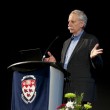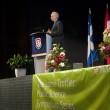Last week, the McGill Office of Science and Society hosted the Lorne Trottier Public Science Symposium, a lecture series that brings science to the public.
Food: A Serving of Science featured four lectures on the science of diet and nutrition. The panelists explored topics ranging from fad diets to the enduring culinary misinformation spread by a 19th century chemist.
Dr. Walter Willett—Diet and Health: A Progress Report
The first speaker, Dr. Walter Willett, is a physician and nutrition researcher from Harvard University. Willett’s talk focused on the failings of North American dietary recommendations. He singled out the low-fat movement and milk consumption as two pieces of health advice that have been disproved by research.
In observational studies, the much-touted low fat diet has actually been linked to weight gain. The problem, according to Willett, is that North Americans simply traded refined sugars and processed carbohydrates for fats, to the detriment of their waistlines. Instead, dietary guidelines should focus on the type of fats and carbohydrates consumed.
He also showed the traditional—and current—Canadian recommendation of drinking two to three glasses of milk per day is not beneficial and may be harmful in some cases. While the guideline is touted as a bone health measure, studies show that drinking milk does not reduce the risk of osteoporotic bone fractures.
Jeffery Blumberg—Evidence-Based Nutrition: The Problem of Proof
If you’re not sure whether or not to take vitamins, you’re not the only one. Jeffrey Blumberg, a professor of nutrition from Tufts University, presented his explanation for the constant contradictions between one vitamin study and the next.
While randomized clinical trials are regarded as the ultimate test, Blumberg argues that researchers shouldn’t be so quick to disregard observational studies, their less controlled counterparts. Randomized clinical trials are a tightly controlled test of a random group, generally used in the pharmaceutical industry. Half the participants are given the drug, and the other half, a placebo. In studies of nutritional supplements, Blumberg asserts, it is impossible (not to mention unethical) to deprive one group of vital nutrients, therefore the test can only compare two groups who are taking different doses of the supplement.
Blumberg believes researchers must develop better experimental methods to test nutritional variables. In the meantime, observational studies provide helpful guidelines that shouldn’t be ignored.
Jane Brody—Eat for Life: Separating Wheat from Chaff
“sGood nutrition is not rocket science,” according to Jane Brody, a New York Times columnist and author who has been dispensing nutrition advice for the last 30 years. While Brody is not a university-trained nutritionist, her background in biochemistry and relentless pursuit of the truth behind various diet fads and studies has earned her an international readership.
In her talk, Brody explained how to spot a bad fad diet, arguing that healthy eating habits have changed very little over the course of human history. She advised the audience to follow the advice of Michael Pollan, author of the Omnivore’s Dilemna who coined the mantra, “Eat food. Not too much. Mostly plants.”
Many of the questions following the lecture were directed to Brody, asking for everyday nutritional advice, although one brave audience member jokingly defended bacon—asking, “What’s moderation for bacon? Once a week? Once a day? Once a meal?”
Harold McGee—Playing With Food: Four Centuries of Science in the Kitchen
Harold McGee quit science for literature early in his academic career, only to find himself publishing a paper in Nature. His paper, on the science behind the French tradition of whipping egg whites in a copper bowl, was inspired by a Julia Child recipe.
A playful curiosity, and a preoccupation with the science of the kitchen, propelled McGee’s career as an author and amateur experimenter. In one case, puzzled by grease spatters that only appeared on the inside of his eye glasses, McGee set up eye glass ‘sensors’ throughout the kitchen to collect data on the strange phenomenon. It turned out that grease particles, thrown high into the air, were drifting down into his glasses from above as he bent over the pan.
McGee’s lecture gave an overview of science in the kitchen from its early beginnings to the current advances in restaurant cooking that include precision temperature cooking and extracting aromas using a device called a rotary evaporator.
One anecdote involved a 19th century chemist named Justus Lieberg, who initiated the popular notion that searing meat seals in its juices, a theory that seems logical considering practices like cauterization. Despite the fact that this theory can be easily disproved by watching juices run out of a seared steak, it is a persistent culinary myth that still appears in cooking text books: evidence that sometimes bad science is worse than no science.









